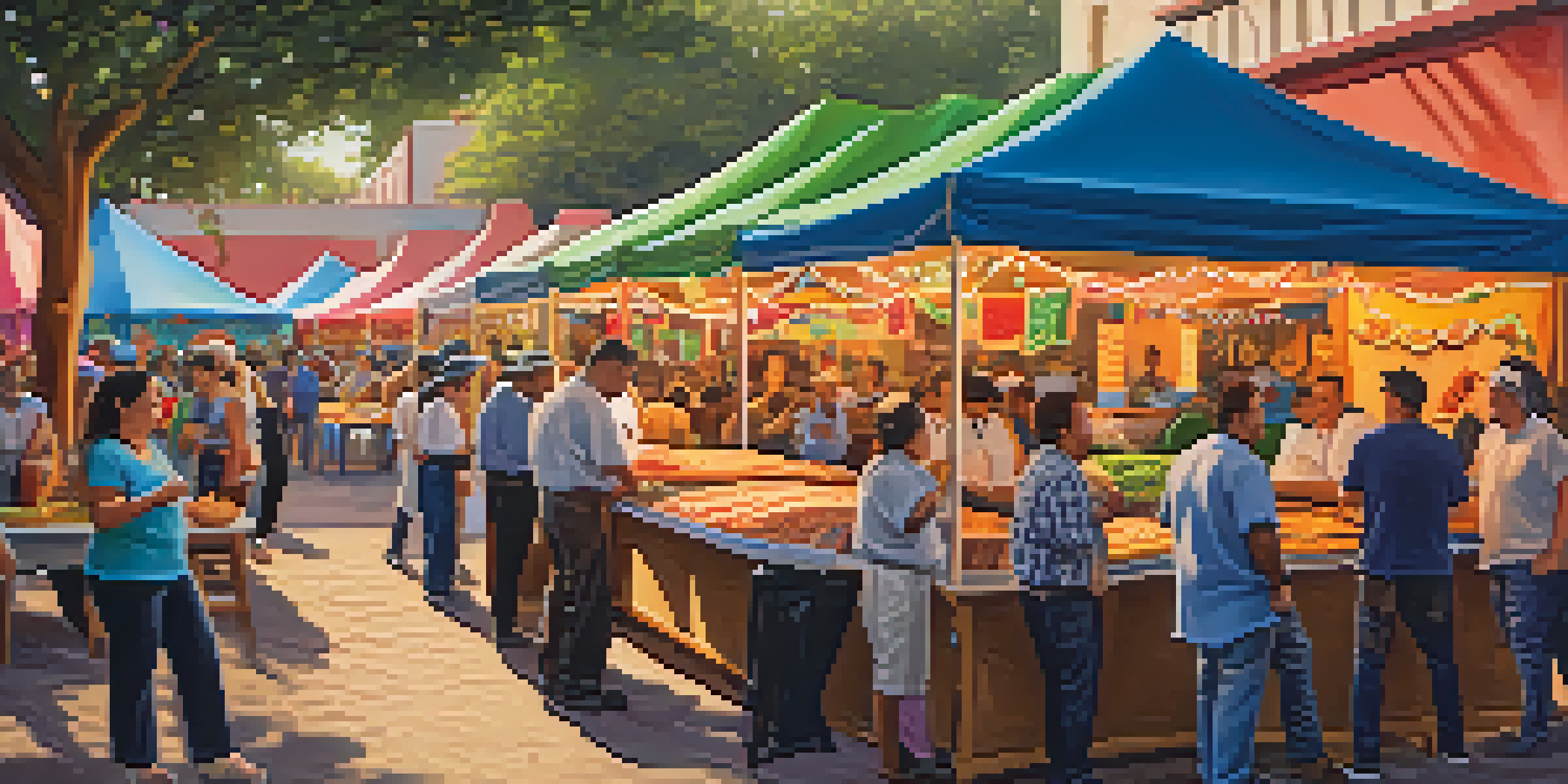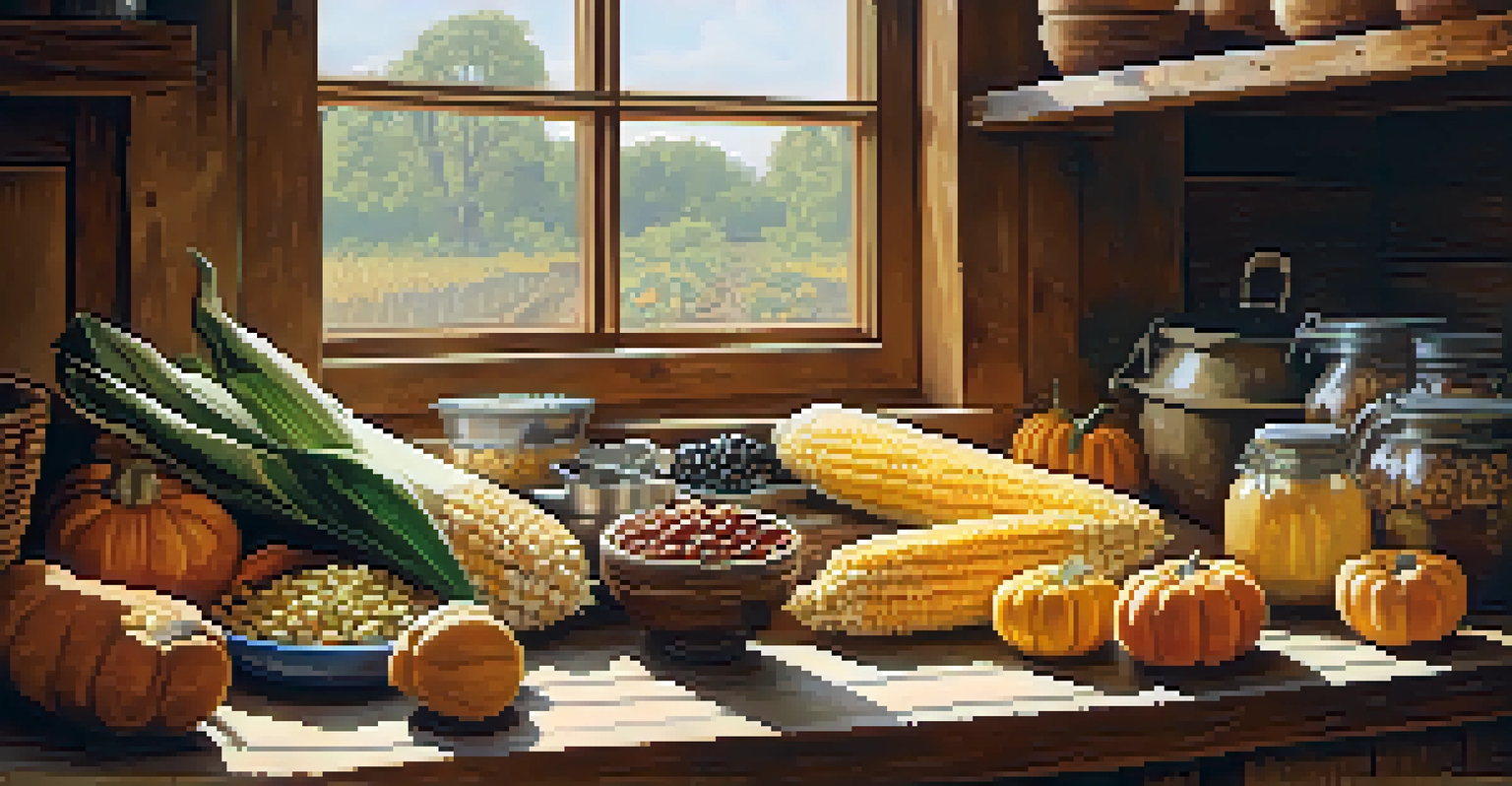Culinary Influences: How History Shaped San Antonio's Cuisine

The Spanish Legacy: Foundations of San Antonio Cuisine
San Antonio's culinary journey begins with its Spanish roots, which established a rich foundation for the area's food culture. The influence of Spanish settlers introduced essential ingredients like rice, beans, and spices, which have become staples in Tex-Mex cuisine. Dishes such as paella and empanadas reflect this heritage, demonstrating how the fusion of flavors set the stage for future culinary developments.
Food is our common ground, a universal experience.
As settlers blended native ingredients with their traditional recipes, a unique culinary identity emerged. For example, the incorporation of indigenous foods like corn and chili peppers created a vibrant palette of flavors that define San Antonio's dishes today. This blending of cultures not only enriched local cuisine but also laid the groundwork for what would become a celebrated food scene.
As time went on, the Spanish influence remained prominent, with many traditional practices continuing in modern kitchens. Festivals, such as Fiesta San Antonio, celebrate this heritage, showcasing the lasting impact of Spanish culinary traditions. Thus, the Spanish legacy is undeniable, forming the backbone of San Antonio's diverse culinary landscape.
Native American Contributions to Local Ingredients
Long before European settlers arrived, Native American tribes were cultivating a variety of crops that would shape the region's cuisine. Corn, beans, and squash—often referred to as the 'Three Sisters'—were fundamental to their diet and continue to be essential ingredients in contemporary dishes. This agricultural knowledge not only provided sustenance but also influenced cooking methods and flavor profiles.

The use of indigenous herbs and spices, such as cilantro and various peppers, has remained a cornerstone of San Antonio's culinary identity. Traditional cooking techniques like roasting and steaming, which were practiced by Native Americans, are still employed today, adding depth and authenticity to local dishes. The synergy between these natural ingredients and modern recipes showcases the enduring legacy of Native American culture.
Cultural Fusion Shapes Cuisine
San Antonio's culinary landscape is a rich blend of Spanish, Native American, Mexican, German, and Czech influences, creating a unique and diverse food scene.
Moreover, the incorporation of local game and fish into the diet illustrates how Native American tribes adapted to their environment. This practice not only diversified the food options available but also emphasized the importance of sustainability and respect for nature. Their contributions are a crucial part of San Antonio's culinary narrative, highlighting the region's rich cultural tapestry.
Mexican Influence: A Flavorful Evolution
With the establishment of Mexico as an independent nation, the culinary landscape of San Antonio began to evolve dramatically. Mexican cuisine introduced bold flavors, vibrant colors, and various cooking techniques that continue to shape the city's food scene. Dishes like tacos, enchiladas, and tamales became household favorites, showcasing the fusion of cultures that defines San Antonio's cuisine.
The discovery of a new dish does more for the happiness of mankind than the discovery of a star.
The incorporation of ingredients such as avocado, tomatoes, and various types of cheese further enriched local recipes. Street vendors and family-run restaurants began to pop up, serving up authentic fare that resonated with both locals and visitors alike. This grassroots movement not only preserved traditional recipes but also encouraged innovation, leading to the birth of new culinary creations.
Moreover, the celebration of Mexican holidays and traditions, such as Día de los Muertos and Cinco de Mayo, has solidified the importance of Mexican cuisine within San Antonio's cultural identity. These events often feature food as a central element, bringing together communities to share in the rich tapestry of flavors. The Mexican influence remains a driving force in San Antonio's culinary scene, ensuring its continued evolution.
German and Czech Influences: A Unique Blend
In the 19th century, waves of German and Czech immigrants arrived in San Antonio, bringing with them their own culinary traditions. This influx introduced new flavors and techniques, creating a unique blend that would further diversify the city's cuisine. Dishes such as sausage, sauerkraut, and kolaches became popular, showcasing the rich tapestry of immigrant contributions.
The combination of German and Czech cooking styles with Tex-Mex cuisine led to innovative dishes that are beloved by many today. For instance, the famous breakfast taco often features smoked sausage or brisket, reflecting this fusion of cultures. Local breweries also emerged, inspired by German beer-making traditions, adding a refreshing complement to the culinary experience.
Festivals Celebrate Culinary Heritage
Festivals in San Antonio highlight the city's diverse culinary traditions, fostering community and educating attendees about the historical significance of various dishes.
Festivals celebrating German and Czech heritage, such as Oktoberfest, highlight the importance of these immigrant groups in shaping San Antonio's food culture. These events create opportunities for communities to come together, sharing traditional recipes and celebrating their unique culinary contributions. The impact of these cultures is evident in the city's diverse cuisine, adding depth and character to its culinary narrative.
Modern Culinary Trends: A Contemporary Take
As we move into the modern era, San Antonio's culinary scene has embraced a plethora of trends that reflect the city’s evolving identity. Chefs are increasingly experimenting with fusion cuisine, blending traditional recipes with global influences to create exciting new dishes. This approach not only honors the city’s rich history but also invites innovation and creativity in the kitchen.
Farm-to-table practices have also gained traction, emphasizing the use of locally sourced ingredients to create fresh and flavorful meals. This trend not only supports local farmers but also highlights the region's agricultural bounty, setting the stage for a vibrant dining experience. With a focus on sustainability, many restaurants now prioritize seasonal ingredients, making each dish a celebration of what the land has to offer.
Moreover, the rise of food trucks and pop-up dining experiences has introduced a new level of accessibility and diversity to San Antonio’s culinary landscape. These platforms allow chefs to showcase their creativity and experiment with flavors, bringing unique offerings to different neighborhoods. As modern culinary trends continue to evolve, San Antonio remains a melting pot of flavors, honoring its historical roots while looking towards the future.
The Role of Festivals in Celebrating Culinary Diversity
Festivals play a crucial role in promoting and celebrating San Antonio's rich culinary diversity. Events like the San Antonio Food and Wine Festival and the Taste of the Northside bring together chefs, restaurants, and food enthusiasts, creating an opportunity for the community to explore various culinary offerings. These gatherings not only showcase local talent but also highlight the city’s cultural heritage through food.
During these festivals, attendees can experience a whirlwind of flavors from different culinary traditions, allowing them to appreciate the intricate connections between history and cuisine. The vibrant atmosphere fosters a sense of community, encouraging people to come together over shared meals and experiences. It's a celebration of not just food but also the unique stories and traditions that accompany each dish.
Future Trends Emphasize Sustainability
The future of San Antonio's culinary scene is focused on sustainability, local sourcing, and innovative dining experiences that honor traditional flavors.
Moreover, these events often feature cooking demonstrations, workshops, and tastings, providing valuable insights into the culinary arts. By educating attendees about the origins and techniques behind various dishes, these festivals foster a deeper appreciation for San Antonio’s culinary heritage. Ultimately, they serve as a reminder of the city’s diverse history and the flavors that have shaped its identity.
The Future of San Antonio's Culinary Scene
As San Antonio continues to grow and evolve, its culinary scene is poised for exciting developments. The city is increasingly becoming a destination for food lovers, attracting chefs from all over who are eager to contribute to its vibrant culture. With this influx of talent, we can expect to see even more innovative dishes that honor the past while pushing culinary boundaries.
The focus on sustainability, local sourcing, and health-conscious dining options is likely to remain a priority within the culinary community. As more people become aware of the importance of environmental responsibility, restaurants will continue to adapt their menus to reflect these values. This shift will not only benefit the community but also enhance the overall dining experience, making it more meaningful.

Ultimately, the future of San Antonio's culinary scene holds promise as it embraces its rich history while looking towards new horizons. By celebrating its diverse influences and fostering innovation, the city’s cuisine will continue to thrive, offering residents and visitors alike an unforgettable taste of its heritage. San Antonio will undoubtedly remain a culinary destination that honors its past while embracing the future.